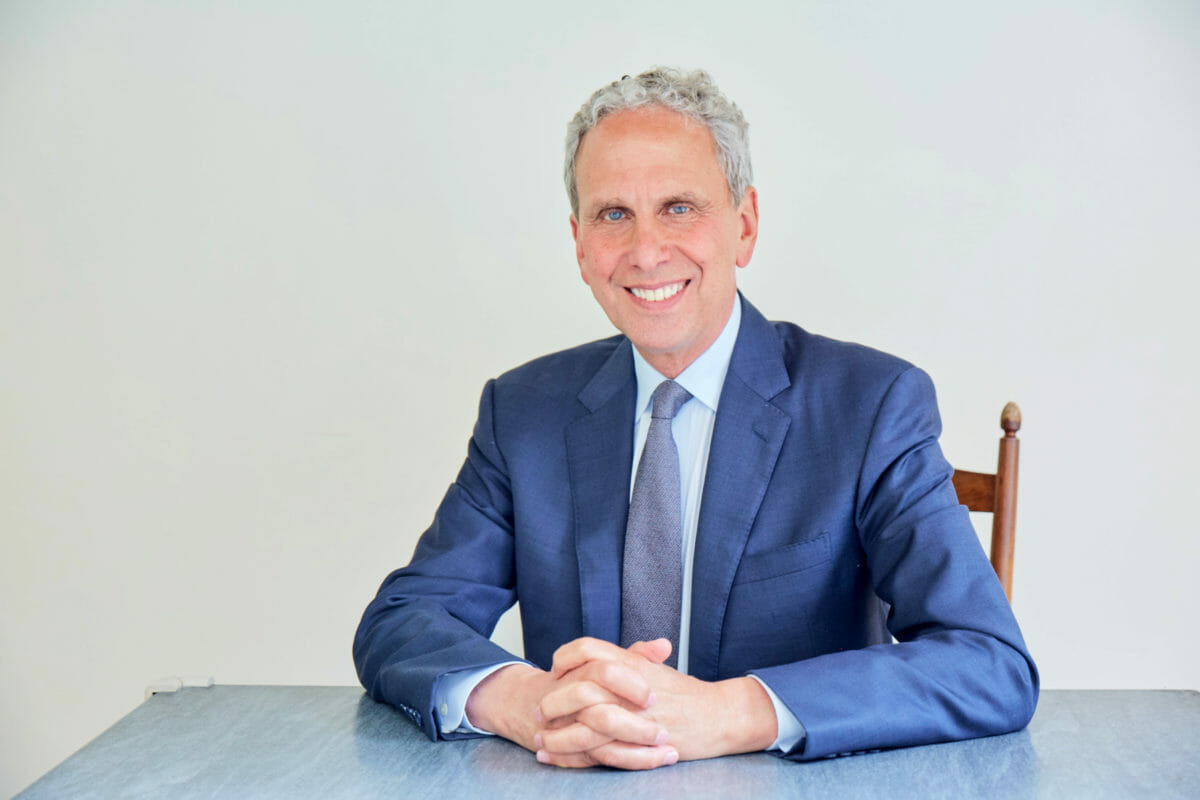
Bob Roth c. Alexander Berg courtesy DLF
Bob Roth is America’s favorite Transcendental Meditation teacher
For more than 45 years he has brought Transcendental Meditation (TM) to millions of people through his role as CEO of the David Lynch Foundation, as host of SiriusXM radio show, Success Without Stress, through his podcast Stay Calm, available on the iHeart radio network, and as the New York Times best-selling author of Strength Into Stillness. (Now available in paperback!)
Bob’s work has improved the lives of students in underserved schools in 35 countries; military veterans and their families who suffer from post-traumatic stress; women and children who are survivors of domestic violence, incarcerated and homeless populations and more. He has taught titans of industry, government, sports and entertainment, including Oprah Winfrey, George Stephanopoulos, Martin Scorsese, Jerry Seinfeld, Howard Stern, Katy Perry, Hugh Jackman, Robin Roberts, and many more.
Roth’s contagious compassion, exceptional intelligence, and light-hearted humor are always an honor to be around. In the following exchange we learn more about this proven practice.
What Is Transcendental Meditation?
Amy: First can you just tell us what Transcendental Meditation is?
Bob Roth: Transcendental Meditation is a very simple, easily learned, effortless practice that allows any person to access a field of calm and science that already exists underneath all the noise, deep within everyone. Just like an ocean has choppy waves at the surface but is silent at its depths, every human being has a silence deep within. We’ve just lost access, we’re stuck up here [points to his head].
It’s practiced for 20 minutes, twice a day, sitting comfortably in a chair, you don’t have to sit in any strange position. You’re given a mantra which is a word or sound that has no meaning in TM, just a couple of syllables. Then you’re taught by a teacher to dive within.
It’s easy, it’s effortless, it’s so tender and gentle and kind and compassionate a meditation. It’s not a strain. It has huge health benefits.
TM For Better Health
Amy: What are some of the benefits?
Bob Roth: Benefits of the meditation, according to research, are very significant. I’ll give you an example: it takes about five and half or six hours of a good night’s sleep for your body to take your metabolic rate to drop about 8%, so that’s a good night’s sleep. In 20 minutes of TM your metabolic rate drops 16%, twice as deep, in just a few minutes.
You know what cortisol is? Too much of it is a bad thing. What they’ve found is if you get a good night’s sleep, cortisol drops about 10 %. During 20 minutes of TM they drop 30-40%. So the first thing that happens is a huge reduction of stress, improvement in sleep, much less anxiety because cortisol goes down.
Sorry about all the science here.
Amy: I love it…! The facts help eradicate that outdated “woo woo” stigma around these proven practices.
Bob Roth: Right.
There’s a neurotransmitter called serotonin. Serotonin is called the happiness neurotransmitter or the well-being neurotransmitter. When a person is depressed – and people are that way now during this whole thing – there’s a real decrease, a sharp decline in serotonin.

TM courtesy DLF
Antidepressant medications like Prozac mimic serotonin. During TM just as there’s a decrease in the anxiety hormone cortisol, there’s an increase in the happiness neurotransmitter serotonin. They both maintain that through the whole meditation and afterwards, through the rest of the day. A person feels stronger inside, happier inside, less anxious, less stress. Research shows that they sleep better at night, that they feel better throughout the day. The research on the brain shows that they think more clearly, and are more resilient. Lots of real good things that we would all love to have.
This is important. It’s not a philosophy, not a religion, nothing you have to believe in. Just a lovely simple technique. It’s not in opposition to anything. People can do other forms of meditation, they can do prayer, they can do exercise – TM fits in nicely with everything.
TM For Clarity of Mind
Amy: I love the old joke, “If you think you don’t have time to meditate for 20 minutes then you need to do it for 40.”
Bob Roth: The reason that is, is because your mind is not clear. There are 1,440 minutes in a day. If you don’t have 30 minutes, or 20 minutes out of that 1,440 minutes to take care of your brain for self-care, then your life is not well-organized and your brain is not clear. That’s why they say you need 40, because you’re in serious trouble!
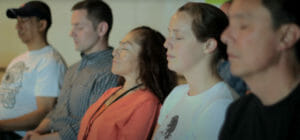
Meditate American courtesy DLF
Amy: Yet, our society seems to run on this bigger, better, faster, more syndrome. In the ‘80s and the ‘90s it was actually “cool” to be stressed out. Where do you think we are with that now?
Bob Roth: The fact of the matter is, it is a crazy world! To be successful, to succeed, to pay your bills, to grow the way you want to grow, to feel like you’re expanding; in your career you want to do more, you want to be more creative, have more influence, then we want to do more. But what TM does is give us an inner equanimity and an inner steadiness so we can do all of that and not get all tied up in knots.
I use the ocean analogy. The ocean is both active and silent. The mind is both active, dynamic but inside silent, quiet, calm. What TM does is give us the energy, the clarity and the inner balance so we can do all of those things and not go crazy.
TM For Sports + Performance
Amy: We’re now seeing a rise in professional athletes turning to TM for performance enhancement. Can you tell me about your experience in sports franchises?
Bob Roth: Oh yes…! There are two aspects to performance. One is what happens biochemically with cortisol. If I am anxious, then my adrenal glands secrete cortisol which is a stress hormone. I need a little cortisol to get going in the day but not too much. My body secretes cortisol if I’m worried about something, then I get more anxious and secrete more cortisol and it becomes a vicious cycle. Two of the problems with cortisol is it affects my immune system, so it weakens or compromises my immune system so I get sick more often. The other thing that it does – it floods my hippocampus which is the memory center. Now, say you have a 10-year-old child and they’re a sensitive soul and they study very hard for the test. Then they get anxious before the test, the test comes, their body secretes cortisol. It floods the hippocampus and they can’t remember anything.
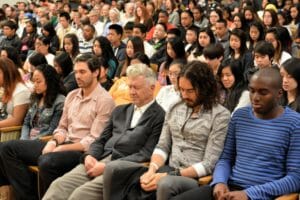
MLB’s Barry Zito, David Lynch, Russel Brand and others at DLF Quiet Time in Schools Event – San Francisco courtesy DLF
Amy: That happens to a lot of people. Geniuses in their field, but terrible test takers.
Bob Roth: A lot of people. When you talk about the athlete who choked under pressure. It’s that. The athlete knows how to shoot a free throw, to catch a ball. But when the cortisol floods the hippocampus they freeze, they choke. So when you have a way to reduce your anxiety levels dramatically during TM then you’re not constrained, you’re not having that reactive thing.
The second thing that it does is it speeds up mind/body coordination. It wakes up part of the brain for focus, reactivity, quickness. It calms the part of the brain, the amygdala, which gets very anxious. So this is a dream come true for any athlete.
Amy: Makes sense, an obvious, proven way, to sharpen skills and performance.
You mentioned a sensitive 10-year-old child. I know you’ve taught many children over the years, who have grown up into amazing adults, who have then taught more children. They’re some of the steadiest people I know. How have you witnessed these generations, sort of re-wire reactions to outside circumstances?
Bob Roth: You just said it right there. Re-wire. There are neural pathways in the brain. They’re pathways in the brain – like when you’re young and you’re learning to tie your shoe. It takes a while. You try and you fumble, and you try and then you keep trying and all of a sudden ‘click’ you got it. And you don’t forget it. Or you’re learning to ride a bike, wobble wobble wobble and then you’ve got it. Or a stick shift or something.
Those are neural pathways in the brain doing something that became familiar. What the problem is with kids, is that they become neural pathways for anxiety, tension, fear, fear of failure, stress. Anything that comes up, there’s a test that’s two months away or a paper, already those pathways, those highways are there.

Children meditating in school courtesy DLF
What happens when you do TM is that it establishes new neural pathways in the brain. Healthier neuropathways. Calmer. All the different parts of the brain are now, instead of going crazy, are now functioning in an integrated, more communicative way. So then the brain is functioning more efficiently. So as far as academic performance, or in business, just being able to stay steady when everything is crazy. In your profession with deadlines. We need that. We need to have that equanimity. We can’t go the old route of, “Somebody pushes my buttons and I overreact.” No! Then we’re a victim of the past.
It’s like, “I had a bad relationship with someone five years ago and I have reactivity to that. Now I’m in a new relationship and I’m still in five years ago. I can’t trust the person. But that person did nothing – I’m in five years ago.” So the ability to meditate and have your mind settle down to that unboundedness inside and have your brain, all the different parts of the brain connect together. Then that forges new neural pathways and then you’re freed from the past, you’re yourself. And it allows you to see maybe this guy is a loser too! So you can see it fresh rather than just reacting. This guy may be great! But if you’re only reacting from the past you’ll never know.
TM For Trauma
Amy: How have you seen this benefit trauma survivors?
Bob Roth: Same thing – the healing. We work with veterans. PTSD is contagious. With veterans they have serious hyperarousal of the amygdala, which is that ‘fight or flight’ area of the brain. So they’re overreacting to everything and that area of the mind for equanimity and calm is offline. High levels of cortisol. Such high levels of anxiety that they start self-medicating and it becomes a downward cycle.
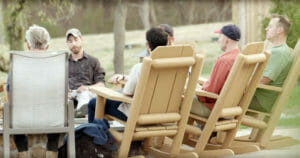
Veterans Mediating On Retreat
Research that was conducted in the San Diego VA Medical Center a few years ago showed that TM was, in many ways, better than anything that the VA is using right now to help veterans in reducing the symptoms of PTSD. We’re working on a new thing called “Healing the Healers,” which is bringing meditation to doctors and nurses on the front lines who are suffering from PTSD themselves.

Active Duty Military Meditating courtesy DLF
Amy: In recent years we saw so many doctors and nurses go through significant trauma, as though they were in a warlike environment with astronomical death tolls. The stories from family members who work in ERs in the New York/New Jersey Area are horrific.
Bob Roth: Totally. This whole field is called ‘Moral Injury’. That is – you’re a nurse. You have one ventilator and there are two people that are dying. And you have to decide. YOU have to decide, with the families behind the glass wall looking, who lives and who dies, who gets the ventilator and who doesn’t. That is horrible trauma. Our Heal the Healers is the initiative in which we’re working with hospitals to serve all the healthcare workers on the front line.

Heal the Healers in hospitals courtesy DLF
What we want to do is take TM away from the “Oh that’s for celebrities, for rich people who can mess around.” This is a medical intervention that has to go to everybody. That’s what we’re working on – to have the research done that shows how effective it is so that the government and Medicare and insurance companies will reimburse it.
TM To The People
Amy: I heard you now have an office in DC to help with these kinds of initiatives?
Bob Roth: Yes, right near Capitol Hill. Before the lockdown happened, we were teaching a lot of members of Congress on both sides of the aisle to meditate. So that they can help move these things … and not just TM. Other evidence-based integrative approaches to healthcare. It is clear medicine isn’t going to do it all – they’ve got to look outside the box. But it should be proven to work, not just new age mumbo jumbo. I know I shouldn’t say that with you in LA. [laughter].
Amy: [Laughs] Ha, I know, the epicenter of the new age. Now, what about the marginalized communities DLF has gone into? There can be a lot of trauma and scarcity in those environments to work through.
Bob Roth: They say that the first 1,000 days of a child’s life, from conception to the second birthday is the most impactful 1,000 days that person will ever have. So if they grew up with trauma, neglect – did you know that neglect is more traumatizing for an infant than physical abuse? You’re just left there. Alone. Neglect is more traumatizing. A lot of these youngsters have that kind of trauma from birth. In Washington DC, we’re in community centers. We’re teaching, for free, great-grandchildren all the way up to great-grandparents. So whole families are learning to meditate. Again, all religions, all backgrounds. It’s the tool of the times, we need it now more than ever.
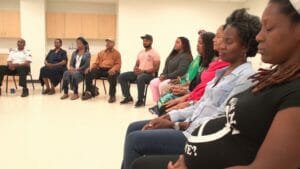
Meditators at the David Lynch Foundation, Washington, DC
Amy: It’s said that if one person is healed that it heals seven generations back and seven generations forward.
Bob Roth: That’s true. American Indians say that and the Vedic literature also says that.
Amy: Sounds like you’re doing a lot of clearing there!
Bob Roth: It’s a wonderful thing on so many levels to do.
If You’re Going To Change The World, Start With Yourself
Amy: How did you come to TM? It seems to be a magic carpet for you.
Bob Roth: [laughs] It’s been!!!
I started as a college student. I was 18 years old. I had worked for Senator Bobby Kennedy in high school and I saw him speak in San Francisco at San Francisco Civic Auditorium on June 1st 1968 and I thought, “Oh we’re going to change the world!” It wasn’t that I was a Republican or a Democrat, it was just that we were 2,000 people and we were going to change the world. And, Amy, four days later he was killed. That had a huge impact on my life.
I vowed when I went to college that I would go to law school and become a United States Senator and change the world, like Bobby Kennedy was going to do. I thought the way to change the world was through legislation, through laws. It took me about one month in college in 1968 to realize that politics is important, but it’s not going to be my path to change the world.
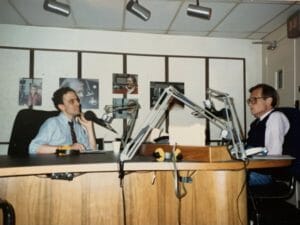
Bob Roth early in his career on the Larry King Show courtesy DLF
Then I thought, “Well, my mom was a school teacher, so what if I write educational curricula? What if I give tools at a very early age, kindergarten, that they could use to help them navigate?” What I saw even then was going to be a stressful, traumatic world. I was going to school full-time, I was working full-time, there were riots in the streets because of the Vietnam War.
I’m a skeptical guy by nature, I’m stressed, I’m not sure what to do, I wasn’t a druggie. I had this one friend who I really trusted of all the people I knew, who was so normal and down to earth and smart and awake and funny and clear. And he was doing something called Transcendental Meditation and I didn’t know what it was. I decided to find out what it was. I said, “I don’t believe in any of this stuff.” And he held up a pen, and he dropped the pen in my hand and he said, “You don’t have to believe in gravity for the pen to fall.” You don’t have to believe in meditation.
So I learned it. From the first meditation it was so natural and profoundly relaxing. One of my first thoughts after I learned it was, “Oh. So this is the tool I’m going to teach those kids.” June 28, 1969. 50 years later I worked with David Lynch on the Foundation. We brought it to over a million kids and we want to bring it to 10 million kids in the next five years.
Amy: I think you’ll do it .
Bob Roth: Thank you. From your lips to God’s ears.
Everything Is As It Should Be
Amy: Something I ask everybody is, where do you think dharma meets free will? Like, you listening to your friend, and going to that first TM class.
Bob Roth: There’s a wonderful story that I’ll tell you, that relates to that then I’ll answer it. I was with Maharishi somewhere, a big conference. They had been talking about cause and effect. For every action there is an equal and opposite reaction. People were saying you can see some cause somewhere, whether it’s genetic or whatever.
A reporter asked him, “Why is there so much suffering in the world?” And Maharishi said, “Everything is as it should be.” Which seemed kind of harsh. The reporter then said, “Then why are you working so hard to change it?” And he said, “Because everything is as it should be.”
I think what you have is: we have our dharma, we have our path. Built into that path is the opportunity to change that path. The opportunity. You have that opportunity to make a choice. Now you might say that is also driven by dharma. That gets too complicated for me!
I am sort of a simple guy, I just want to make a better world. I meditate twice a day. It gives me the energy.
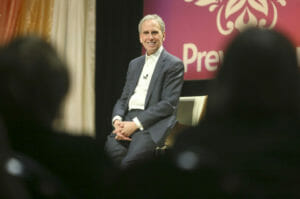
Bob Roth In His Element courtesy DLF
You know. It’s life. You can get knocked down a lot. You have to pick yourself up. In relationships. In jobs. You have to pick yourself back up.
Independent of that, I’m teaching TM, the meditation for me has helped me maintain my resilience. I have more energy now than I had when I was 25. I sleep better now, I feel healthier now than ever. I think it’s just we have free will. we can take care of ourselves, we don’t have to let our bodies just wear down like they inevitably could.
The World Is My Family
Amy: What are some of the other projects the David Lynch Foundation is working on right now, and how can we, the readers of LA Yoga Magazine help?
Bob Roth: There’s a beautiful ancient Vedic proverb that says “Vasudaiva Kutumbakam” which means “The world is my family.” That child that is suffering down the street, or Rwanda, or anywhere, is our child. We can’t. I could cry. We can’t ignore that child. Obviously, we have our own children and we have to feed them and take care of them, but that doesn’t release us from our commitment, our dharma, our responsibility, to do everything we can to make the whole world family. A rising tide needs to lift all boats.

DLF Quiet Time Around The World – Bali courtesy DLF
One thing that can be done through the David Lynch Foundation is help us bring the meditation to the people who need it, in some regards, the most, who are so vulnerable. That 10-year-old child living in the Bronx or – I just came back from Israel and then I was on the West Bank, and I was talking to little Muslim children and Palestinians, the fear that they have.

DLF Quiet Time Around The World – Uganda courtesy DLF
I think one thing is, educate yourself. Go to the David Lynch Foundation.org website. See if there’s something there that resonates with you. If you have the finances to be able to support us, 100% of it goes just to bring TM to the people who need it the most. You can learn to meditate yourself.
One time someone asked Maharishi, “What can a person do to create peace in the world?” He said, “Learn to meditate and become a light unto yourself.” We should all become a light unto ourselves.
Learn More About Bob Roth, the David Lynch Foundation and Transcendental Meditation
Purchase the new paperback version of Strength Into Stillness
Listen to “Stay Calm with Bob Roth”
Learn more about The David Lynch Foundation for Transcendental Meditation.
Watch a TM Intro Video By Bob Roth Here.
Follow Bob Roth on his social media channels, IG, FB, Twitter, LinkedIn.
Author’s Note; Thanks to DLF-LA Regional Director Lynn Kaplan, for her help with this article.
To Check Out Amy’s Work Go To; Sense + Color, You Can Reach Her At IG: Amy_V_Dewhurst + AmyVDewhurst@SenseAndColor.co #PutYourGoodWhereItWillDoTheMost
